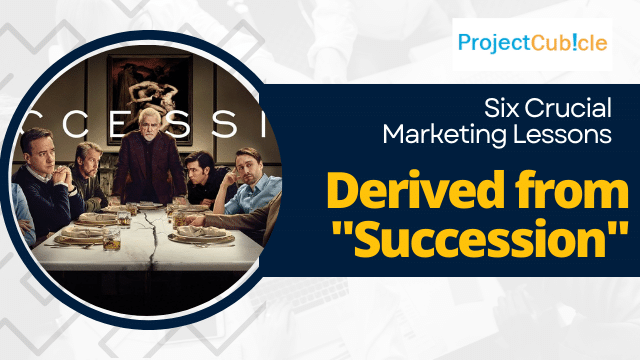Mastering the Game: Six Crucial Marketing Lessons Derived from “Succession”!
In the fast-paced realm of marketing, staying ahead of the curve is paramount. Just like the intricate dynamics portrayed in the acclaimed series “Succession,” the world of marketing demands constant adaptation and strategic finesse. Drawing parallels from the gripping narrative of power struggles and corporate maneuvering, we unravel six indispensable marketing insights to elevate your game and dominate the competition.
Table of Contents
Succession, the HBO television series created by Jesse Armstrong, has garnered widespread acclaim for its portrayal of power dynamics, family conflicts, and corporate intrigue within the Roy family’s media empire. The show not only entertains but also offers valuable insights into the complexities of succession planning, leadership, and human behavior in high-stakes environments.
You’ve all heard of the magnificent series that has taken the world by storm. But was there another lesson beneath the family dramas? Yes, as projectcubicle, we will focus on that!
What is the Lesson Learned from Succession?
Succession teaches us that power struggles, familial conflicts, and ethical dilemmas are inherent in any succession process. It underscores the importance of effective leadership, communication, and strategic planning in navigating such challenges. Through the trials and tribulations of the Roy family, viewers learn about the consequences of unchecked ambition, loyalty, and betrayal in both personal and professional spheres.
Crafting a Compelling Narrative: The Art of Storytelling
In the intricate tapestry of marketing, storytelling reigns supreme as the golden thread that weaves brands into the fabric of consumer consciousness. ‘Succession’ serves as a masterclass in this art, with its rich narrative arcs and multidimensional characters capturing the imagination of audiences worldwide. Take, for instance, the journey of Kendall Roy, whose evolution from heir apparent to a complex figure grappling with personal and professional turmoil mirrors the complexities of modern branding.

Volkswagen’s Think Small Ads
Echoing this sentiment is Apple, a titan of innovation and storytelling. Through iconic campaigns like “Think Different” and “1984,” Apple transcends mere product promotion, imbuing its brand with a narrative that celebrates creativity, rebellion, and the relentless pursuit of excellence. By intertwining its products with compelling narratives, Apple has etched itself into the annals of marketing history, showcasing the transformative power of storytelling in forging emotional connections with consumers.
MORE FROM PROJECTCUBICLE ADVISOR
Navigating Crises: The Roys’ Approach to Damage Control
In the tumultuous landscape of business, crises are not stumbling blocks but rather crucibles that test the mettle of brands and their leaders. ‘Succession’ exemplifies this with its portrayal of the Roy family deftly maneuvering through corporate scandals and personal tribulations, offering invaluable lessons in crisis management.
Drawing parallels is Johnson & Johnson’s handling of the Tylenol poisoning crisis in 1982. Faced with a grave threat to its reputation and consumer trust, Johnson & Johnson’s swift and transparent response, including a nationwide product recall and the introduction of tamper-resistant packaging, set a new standard for crisis management. By prioritizing consumer safety and demonstrating unwavering integrity, Johnson & Johnson not only weathered the storm but emerged stronger, underscoring the importance of ethical leadership and decisive action in times of crisis.
Adaptability in Business: Lessons from Logan Roy
Adaptability is the hallmark of success in an ever-evolving marketplace, a lesson epitomized by Logan Roy’s strategic acumen in ‘Succession.’ As the steward of a media empire navigating turbulent waters, Logan’s ability to pivot, innovate, and embrace change serves as a blueprint for brands seeking to thrive amidst uncertainty.
A shining example of adaptability in action is Amazon, the e-commerce behemoth founded by Jeff Bezos. From its humble origins as an online bookstore to its current status as a global juggernaut spanning diverse industries, Amazon’s relentless pursuit of innovation and willingness to disrupt itself have been central to its meteoric rise. Whether through ventures into cloud computing with Amazon Web Services or pioneering advancements in logistics with Prime delivery, Amazon’s ability to anticipate market shifts and adapt its strategy accordingly underscores the transformative power of adaptability in driving sustained growth and relevance.
Understanding Your Audience: The Power of Market Research
In the symphony of marketing, the audience serves as the conductor, guiding brands toward harmonious resonance with consumer desires and aspirations. ‘Succession’ underscores the importance of audience understanding, as the Roy family leverages market research to inform their strategic maneuvers and cultivate meaningful connections with stakeholders.
Exemplifying this principle is Netflix, a trailblazer in the realm of digital entertainment. Through data-driven insights and analytics, Netflix not only anticipates viewer preferences but also tailors content recommendations and user experiences with surgical precision. By placing the audience at the heart of its operations, Netflix has transcended traditional media boundaries, captivating audiences worldwide and redefining the future of entertainment consumption.
Study Case: Netflix
- Advanced Data Analytics: Netflix employs advanced data analytics techniques to gather and analyze vast amounts of user data. This includes not only demographic information but also viewing habits, preferences, search history, and even pauses or rewinds during content consumption. By mining this data, Netflix gains valuable insights into what resonates with different audience segments.
- Machine Learning Algorithms: Netflix utilizes sophisticated machine learning algorithms to process the data collected. These algorithms can predict user preferences and behavior patterns with a high degree of accuracy. For example, they can recommend content similar to what a user has previously watched, predict which new releases will be popular based on past viewing trends, and even customize artwork and thumbnails to appeal to individual tastes.
- Content Creation and Acquisition: Armed with insights from its data analysis, Netflix makes strategic decisions about content creation and acquisition. It invests in producing original programming across a wide range of genres to appeal to diverse audience interests. Additionally, Netflix uses data to inform licensing agreements, acquiring the rights to content that aligns with the preferences of its subscriber base.
- User Experience Optimization: Beyond content recommendations, Netflix also optimizes the user experience based on data insights. This includes everything from the layout and design of the platform to the functionality of features like autoplay and skip intros. By continually refining the user experience, Netflix aims to keep audiences engaged and satisfied with their streaming service.
Overall, Netflix’s success stems from its ability to harness the power of data to understand its audience intimately and deliver personalized experiences at scale. By constantly refining its algorithms and leveraging insights gleaned from user data, Netflix remains a trailblazer in the realm of digital entertainment, setting the standard for audience-centric content delivery in the modern era.
The Art of Negotiation: Deal-making à la Roy
Negotiation is the crucible where strategy meets diplomacy, forging alliances and shaping destinies in the crucible of commerce. ‘Succession’ offers a compelling portrayal of negotiation dynamics within the cutthroat realm of corporate intrigue, illuminating the delicate dance of power, persuasion, and compromise.
A paragon of negotiation prowess is Microsoft’s acquisition of LinkedIn in 2016. In a landmark deal valued at $26.2 billion, Microsoft’s CEO Satya Nadella demonstrated a masterful blend of strategic vision and tactical finesse, securing a transformative asset that complemented Microsoft’s existing suite of products and services. By recognizing synergies, articulating value propositions, and navigating complex regulatory landscapes, Microsoft exemplified the art of negotiation at its zenith, paving the way for unprecedented growth and innovation in the digital ecosystem.
Brand Loyalty and Roy Family Dynamics: A Unique Perspective
In the pantheon of marketing, brand loyalty is the Holy Grail, a testament to the enduring bond forged between brands and their devotees. ‘Succession’ offers a unique lens through which to explore this phenomenon, as the intricate dynamics of the Roy family mirror the complexities of brand loyalty in the corporate arena.
A quintessential example is Disney, a global powerhouse synonymous with magic, nostalgia, and cherished memories. Through generations of families, Disney has cultivated an unparalleled sense of loyalty, transcending mere consumerism to become a cherished part of cultural heritage. Whether through timeless classics like ‘The Lion King’ or immersive experiences at Disney theme parks, Disney has fostered a sense of belonging that transcends demographics and borders, exemplifying the transformative power of brand loyalty in building enduring legacies.

From Logan Roy and his family, we can learn valuable lessons about marketing
Leveraging Media Influence for ROI
In the digital age, the currency of influence reigns supreme, with media serving as the conduit through which brands amplify their message and cultivate relationships with consumers. ‘Succession’ offers a masterclass in leveraging media influence, as the Roy family navigates the intricacies of public perception and media scrutiny with finesse.
Strategic Partnerships with Athletes:
Nike’s strategic partnerships with high-profile athletes have been instrumental in leveraging media influence. By aligning with athletes who embody the brand’s values of athleticism, determination, and excellence, Nike not only gains access to their vast fan bases but also benefits from the positive association with their achievements. These partnerships often extend beyond traditional endorsement deals, with Nike collaborating closely with athletes on product development, marketing campaigns, and community initiatives. Through these partnerships, Nike not only amplifies its message but also builds authentic connections with consumers who admire and aspire to emulate their athletic heroes.
Innovative Advertising Campaigns:
Nike is renowned for its innovative and impactful advertising campaigns that captivate audiences and drive cultural conversation. From iconic slogans like “Just Do It” to emotionally resonant storytelling, Nike’s ads have a knack for tapping into universal themes of determination, resilience, and empowerment. By leveraging powerful visuals, compelling narratives, and cutting-edge production techniques, Nike creates ads that resonate across demographics and inspire action. These campaigns are strategically disseminated across various media channels, including television, digital platforms, and social media, maximizing their reach and impact.
Pervasive Presence Across Media Platforms:
Nike maintains a pervasive presence across both digital and traditional media platforms, ensuring that its message reaches consumers wherever they are. Whether through high-profile sponsorships of major sporting events, strategic product placements in popular TV shows and movies, or engaging content on social media channels, Nike maintains a consistent and ubiquitous presence in the media landscape. This omni-channel approach allows Nike to connect with consumers at multiple touchpoints throughout their daily lives, reinforcing brand awareness, loyalty, and affinity.
ROI and Business Success:
Nike’s strategic use of media influence has translated into substantial ROI and business success. By investing in high-impact marketing initiatives that resonate with consumers, Nike has consistently grown its market share, expanded its global footprint, and increased its revenue and profitability. Beyond financial metrics, Nike’s brand equity and cultural relevance have also soared, solidifying its position as a market leader and driving long-term sustainable growth. Nike’s ability to effectively leverage media influence to drive business outcomes underscores the transformative power of strategic marketing in today’s digital age.
Drawing inspiration is Nike, a titan of athletic apparel and marketing prowess. Through strategic partnerships with athletes, innovative advertising campaigns, and a pervasive presence across digital and traditional media platforms, Nike has cultivated a formidable brand presence that transcends borders and resonates with diverse audiences. By harnessing the power of media influence to amplify its message of empowerment and excellence, Nike has not only achieved substantial ROI but also cemented its status as a cultural icon, showcasing the transformative potential of media in driving business success.
Strategic Media Abstract
In the cacophony of the digital landscape, strategic media abstraction emerges as the linchpin of brand resonance and consumer engagement. ‘Succession’ provides a compelling narrative of media influence and manipulation, offering invaluable insights into the symbiotic relationship between brands and the media ecosystem.
Exemplifying this paradigm is Tesla, a trailblazer in the realm of electric vehicles and disruptive innovation. Through strategic media abstraction, Tesla founder Elon Musk has cultivated a cult-like following and propelled the brand to unprecedented heights of success. Whether through provocative tweets, captivating product launches, or visionary storytelling, Musk harnesses the power of media abstraction to shape perceptions, drive conversation, and fuel consumer enthusiasm. By strategically leveraging media as a vehicle for brand storytelling and audience engagement, Tesla has achieved remarkable ROI and solidified its position as a trailblazer in the automotive industry, underscoring the transformative potential of strategic media abstraction in driving business growth and market leadership.
What Can We Learn from Logan Roy?
Logan Roy, the patriarch of the Roy family and the founder of Waystar Royco, embodies the complexities of leadership, power, and family dynamics. His authoritarian leadership style, Machiavellian tactics, and relentless pursuit of success offer valuable lessons:
- Decisiveness: Logan’s ability to make tough decisions, even at the expense of personal relationships, highlights the importance of decisiveness in leadership.
- Resilience: Despite facing numerous setbacks and challenges, Logan demonstrates resilience and adaptability, traits essential for navigating turbulent times.
- Legacy Building: Logan’s obsession with preserving his legacy underscores the significance of succession planning and building sustainable organizations beyond individual leadership.
Why Succession Planning is Important in Business?
Succession planning is crucial for ensuring the long-term viability and success of businesses for several reasons:
- Continuity: Effective succession planning ensures seamless leadership transitions, minimizing disruptions and maintaining business continuity.
- Talent Retention: It fosters a culture of talent development and retention, motivating employees and nurturing future leaders within the organization.
- Risk Mitigation: By identifying and grooming potential successors, organizations can mitigate risks associated with leadership vacancies, sudden departures, or unforeseen circumstances.
- Strategic Growth: Succession planning enables organizations to align leadership capabilities with strategic objectives, driving innovation, growth, and competitiveness in dynamic market environments.
Why is Succession So Compelling?
Succession captivates audiences with its gripping storytelling, nuanced character development, and exploration of timeless themes such as power, ambition, and morality. Its compelling narrative delves into the complexities of family dynamics, corporate politics, and the human psyche, resonating with viewers on both emotional and intellectual levels.
FAQs (Frequently Asked Questions)
Q: Is Succession based on a real family? A: While Succession is a work of fiction, it draws inspiration from real-life media dynasties and corporate families, offering a fictionalized portrayal of power struggles and familial dynamics in the business world.
Q: How many seasons of Succession are there? A: As of now, Succession has aired three seasons, with each season consisting of ten episodes. The show has been renewed for a fourth season due to its immense popularity and critical acclaim.
Q: What makes Succession stand out from other TV shows? A: Succession stands out for its sharp writing, complex characters, and astute observations on wealth, power, and privilege. It deftly blends drama, satire, and dark humor to create a compelling narrative that keeps viewers eagerly anticipating each new episode.
Q: Who are the main characters in Succession? A: The main characters in Succession include Logan Roy, the patriarch of the Roy family; his children – Kendall, Shiv, Roman, and Connor; as well as key players within the company such as Tom Wambsgans, Greg Hirsch, and Gerri Killman.
Q: What themes does Succession explore? A: Succession explores themes such as family dynamics, corporate greed, ambition, loyalty, betrayal, and the pursuit of power. It offers a nuanced portrayal of human relationships and the moral complexities inherent in navigating the cutthroat world of business and media.
Q: Can Succession teach us valuable lessons about leadership and succession planning? A: Absolutely. Succession serves as a cautionary tale about the pitfalls of unchecked ambition, dysfunctional family dynamics, and the importance of effective succession planning in ensuring the long-term viability and success of businesses.
Hello, I’m Cansu, a professional dedicated to creating Excel tutorials, specifically catering to the needs of B2B professionals. With a passion for data analysis and a deep understanding of Microsoft Excel, I have built a reputation for providing comprehensive and user-friendly tutorials that empower businesses to harness the full potential of this powerful software.
I have always been fascinated by the intricate world of numbers and the ability of Excel to transform raw data into meaningful insights. Throughout my career, I have honed my data manipulation, visualization, and automation skills, enabling me to streamline complex processes and drive efficiency in various industries.
As a B2B specialist, I recognize the unique challenges that professionals face when managing and analyzing large volumes of data. With this understanding, I create tutorials tailored to businesses’ specific needs, offering practical solutions to enhance productivity, improve decision-making, and optimize workflows.
My tutorials cover various topics, including advanced formulas and functions, data modeling, pivot tables, macros, and data visualization techniques. I strive to explain complex concepts in a clear and accessible manner, ensuring that even those with limited Excel experience can grasp the concepts and apply them effectively in their work.
In addition to my tutorial work, I actively engage with the Excel community through workshops, webinars, and online forums. I believe in the power of knowledge sharing and collaborative learning, and I am committed to helping professionals unlock their full potential by mastering Excel.
With a strong track record of success and a growing community of satisfied learners, I continue to expand my repertoire of Excel tutorials, keeping up with the latest advancements and features in the software. I aim to empower businesses with the skills and tools they need to thrive in today’s data-driven world.
Suppose you are a B2B professional looking to enhance your Excel skills or a business seeking to improve data management practices. In that case, I invite you to join me on this journey of exploration and mastery. Let’s unlock the true potential of Excel together!
https://www.linkedin.com/in/cansuaydinim/










